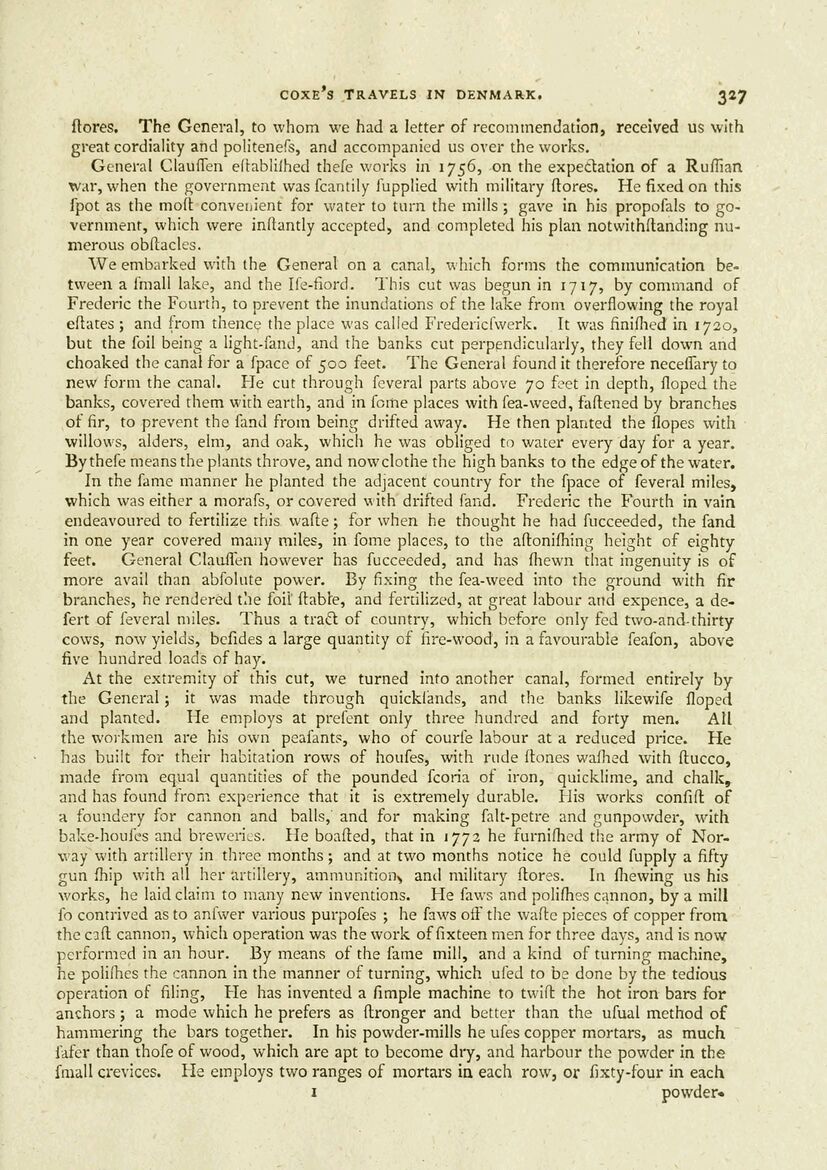
Full resolution (JPEG) - On this page / på denna sida - Pages ...

<< prev. page << föreg. sida << >> nästa sida >> next page >>
Below is the raw OCR text
from the above scanned image.
Do you see an error? Proofread the page now!
Här nedan syns maskintolkade texten från faksimilbilden ovan.
Ser du något fel? Korrekturläs sidan nu!
This page has never been proofread. / Denna sida har aldrig korrekturlästs.
COXE’s TRAVELS IN DENMARK. 327
ftores, The General, to whom we had a letter of recommendation, received us with
great cordiality and politenefs, and accompanied us over the works.
General Clauffen eftablifhed thefe works in 1756, on the expectation of a Ruffian
war, when the government was f{cantily fupplied with military ftores. He fixed on this
fpot as the moft-convenient for water to turn the mills; gave in his propofals to go-
vernment, which were in{tantly accepted, and completed his plan notwith{tanding nu-
merous obitacles.
We embarked with the General ona canal, which forms the communication be-
tween a {mall lake, and the Ife-fiord. This cut was begun in 1717, by command of
Frederic the Fourth, to prevent the inundations of the lake from overflowing the royal
eftates ; and from thence the place was called Frederic{werk. It was finifhed in 1720,
but the foil being a light-fand, and the banks cut perpendicularly, they fell down and
choaked the canal for a fpace of 500 feet. ‘The General found it therefore neceflary to
new form the canal. He cut through feveral parts above 70 feet in depth, floped the
banks, covered them with earth, and in fome places with fea-weed, faftened by branches
of fir, to prevent the fand from being drifted away. He then planted the flopes with
willows, alders, elm, and oak, which he was obliged to water every day for a year.
By thefe means the plants throve, and nowclothe the high banks to the edge of the water.
In the fame manner he planted the adjacent country for the fpace of feveral miles,
which was either a morafs, or covered with drifted fand. Frederic the Fourth in vain
endeavoured to fertilize this wafte; for when he thought he had fucceeded, the fand
in one year covered many miles, in fome places, to the aftonifhing height of eighty
feet. General Clauflen however has fucceeded, and has fhewn that ingenuity is of
more avail than abfolute power. By fixing the fea-weed into the ground with fir
branches, he rendered the foil ftable, and fertilized, at great labour and expence, a de-
fert of feveral miles. Thus a tract of country, which before only fed two-and-thirty
cows, now yields, befides a large quantity of fire-wood, in a favourable feafon, above
five hundred loads of hay.
At the extremity of this cut, we turned into another canal, formed entirely by
the General; it was made through quicklands, and the banks likewife floped
and planted. He employs at prefent only three hundred and forty men. All
the workmen are his own peafants, who of courfe labour at a reduced price. He
has built for their habitation rows of houfes, with rude {tones wafhed with ftucco,
made from equal quantities of the pounded f{coria of iron, quicklime, and chalk,
and has found from experience that it is extremely durable. His works confit of
a foundery for cannon and balls, and for making falt-petre and gunpowder, with
bake-houfes and breweries. He boafted, that in 1772 he furnifhed the army of Nor-
way with artillery in three months; and at two months notice he could fupply a fifty
gun fhip with all her artillery, ammunition, and military ftores. In fhewing us his
works, he laid clatm to many new inventions. He faws and polifhes cannon, by a mill
fo contrived as to anfwer various purpofes ; he faws off the wafte pieces of copper from
the caft cannon, which operation was the work of fixteen men for three days, and is now
performed in an hour. By means of the fame mill, and a kind of turning machine,
he polifhes the cannon in the manner of turning, which ufed to be done by the tedious
operation of filing, He has invented a fimple machine to twift the hot iron bars for
anchors ; a mode which he prefers as ftronger and better than the ufual method of
hammering the bars together. In his powder-mills he ufes copper mortars, as much
{afer than thofe of wood, which are apt to become dry, and harbour the powder in the
{mall crevices. He employs two ranges of mortars in each row, or fixty-four in each
I powders
<< prev. page << föreg. sida << >> nästa sida >> next page >>